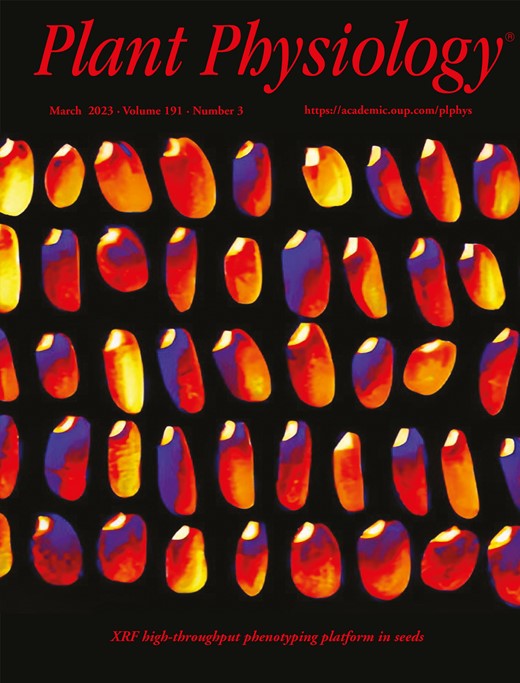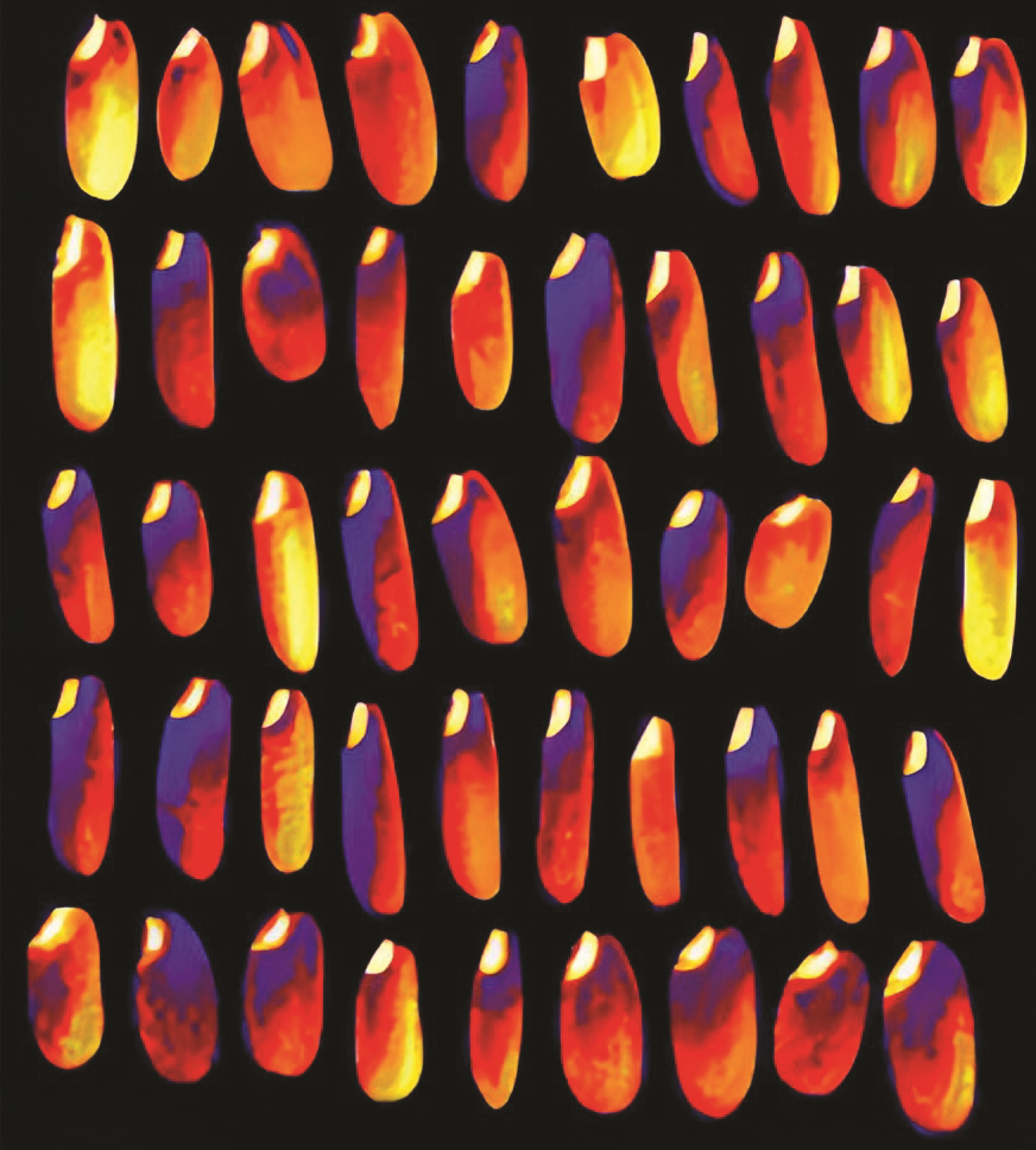
Cover image

Volume 191, Issue 3, March 2023
Thank You to Reviewers and Editors
Thank You to Reviewers and Editors of 2022
News and Views
Phishing alert! A Cas9-based method reveals the identity of promoter-bound transcription factors
Grain scans: fast X-ray fluorescence microscopy for high-throughput elemental mapping of rice seeds
Keeping quiet: cell cycle regulator PIKMIN1 helps maintain the quiescent center
A lotus by any other color: Gene regulation divergence in lotus petal development
When to germinate: the talk between abscisic acid and circadian clock
Topical Review
Shade avoidance in the context of climate change
The signaling network involved in shade avoidance responses integrates information from environmental variables such as temperature, water availability, and salinity.
Research Report
Agave REVEILLE1 regulates the onset and release of seasonal dormancy in Populus
Agave REVEILLE1 regulates bud dormancy and bud break in Populus by repressing multiple dormancy-related genes and up-regulating bud break-related genes.
Research Articles
A reverse chromatin immunoprecipitation technique based on the CRISPR–dCas9 system
A DNA-binding protein capture technology based on the CRISPR–dCas9 system and transient genetic transformation enables identification of upstream transcription factors.
Fast X-ray fluorescence microscopy provides high-throughput phenotyping of element distribution in seeds
Fast X-ray fluorescence microscopy (µ-XRF) provides a high-throughput method to investigate the mechanisms controlling the accumulation and spatial variations of mineral elements in plant seeds.
CyanoMapDB: a database integrating experimentally validated protein–protein interactions in cyanobacteria
SPINDLY O-fucosylates nuclear and cytoplasmic proteins involved in diverse cellular processes in plants
Effective use of legacy data in a genome-wide association studies improves the credibility of quantitative trait loci detection in rice
Plant lineage-specific PIKMIN1 drives APC/CCCS52A2 E3-ligase activity-dependent cell division
Mutations in CmVPS41 controlling resistance to cucumber mosaic virus display specific subcellular localization
One-helix protein 2 is not required for the synthesis of photosystem II subunit D1 in Chlamydomonas
Light, rather than circadian rhythm, regulates gas exchange in ferns and lycophytes
Deadly acceleration in dehydration of Eucalyptus viminalis leaves coincides with high-order vein cavitation
Vein network failure and runaway cavitation represent the critical threshold beyond which leaves are critically damaged and die.
Expression inheritance and constraints on cis- and trans-regulatory mutations underlying lotus color variation
cis- and trans-regulatory variations showing distinct evolutionary patterns and inheritance modes during lotus species divergence contribute to their flower color evolution.
Thermo-Sensitive Spikelet Defects 1 acclimatizes rice spikelet initiation and development to high temperature
THERMO-SENSITIVE SPIKELET DEFECTS 1 (TSD1), encoding a Poaceae-specific FHY3/FAR1 family transcription factor, is highly expressed in spikelets and induced by heat in rice. TSD1 specifically enhances the heat tolerance of spikelet morphogenesis by directly regulating the transcription of YABBY1/3 and physical interaction with YABBY1/3/4/5.
Enhanced genome-wide association reveals the role of YABBY11-NGATHA-LIKE1 in leaf serration development of Populus
The YABBY11-NGATHA-LIKE1 module links environmental signaling to leaf morphological plasticity in poplar.
Endoplasmic reticulum calnexins participate in the primary root growth response to phosphate deficiency
Calnexin, a lectin chaperone engaged in the folding of N-glycosylated proteins in the ER, participates in primary root adaptation to low-phosphate conditions.
The transcription factor PbrbZIP52 positively affects pear pollen tube longevity by promoting callose synthesis
Roles of very long-chain fatty acids in compound leaf patterning in Medicago truncatula
Outermost cell layer-specific biosynthesis of very long-chain fatty acids is critical for the cell membrane integrity, which is important for auxin-mediated compound leaf patterning in barrelclover.
Apple SUMO E3 ligase MdSIZ1 regulates cuticular wax biosynthesis by SUMOylating transcription factor MdMYB30
MdSIZ1 mediates the SUMOylation and accumulation of MdMYB30 protein, which activates expression of MdKCS1 to promote cuticular wax biosynthesis in apple.
Interplay among ZF-HD and GRF transcription factors during Arabidopsis leaf development
Algal PETC-Pro171-Leu suppresses electron transfer in cytochrome b6f under acidic lumenal conditions
P171L substitution in the Rieske FeS PETC subunit of cytochrome b6f alters the pH dependency of the photosynthetic control mechanism.
Characterization of mutants deficient in N-terminal phosphorylation of the chloroplast ATP synthase subunit β
N-terminal phosphorylation of ATP synthase subunit β interferes with complex accumulation during assembly.
Kinase CIPK9 integrates glucose and abscisic acid signaling to regulate seed oil metabolism in rapeseed
Calcineurin B-like interacting protein kinase 9 mediates the interaction between glucose flux and abscisic acid hormone signaling to regulate seed oil metabolism in rapeseed.
A regulatory loop establishes the link between the circadian clock and abscisic acid signaling in rice
SUMO E3 ligase AtMMS21-dependent SUMOylation of AUXIN/INDOLE-3-ACETIC ACID 17 regulates auxin signaling
A superior gene allele involved in abscisic acid signaling enhances drought tolerance and yield in chickpea
A superior allele of a basic helix–loop–helix transcription factor enhances yield in drought-stressed chickpea without compromising agronomic performance.
Disclosing the molecular basis of salinity priming in olive trees using proteogenomic model discovery
A mini-TGA protein modulates gene expression through heterogeneous association with transcription factors
Abscisic acid promotes auxin biosynthesis to inhibit primary root elongation in rice
Abscisic acid activates auxin biosynthesis to inhibit root elongation and promote root swelling in response to soil compaction.
Kinase MxMPK4-1 and calmodulin-binding protein MxIQM3 enhance apple root acidification during Fe deficiency
Calmodulin-binding protein MxIQM3 is phosphorylated by the kinase MxMPK4-1 and then dissociated from central loop of plasma membrane H+-ATPase MxHA2 to enhance root acidification under Fe deficiency.
A brassinosteroid transcriptional regulatory network participates in regulating fiber elongation in cotton
Mitochondrial H2S donor AP39 induces stomatal closure by modulating guard cell mitochondrial activity
The mitochondrial-targeted H2S donor AP39 modulates guard cell ETC activity and cytosolic energetic and oxidative status to induce stomatal closure.
The Medicago SymCEP7 hormone increases nodule number via shoots without compromising lateral root number
The Medicago SymCEP7 peptide hormone has a symbiosis-associated activity that increases nodule number when applied to legume shoots in the picomolar to nanomolar range.




































